The sound disappears in the listening room! ? What is the identity of standing waves?
What is the place where you put a common small speaker? Is there not much living room? This time, I would like to talk about the place where the speaker is placed and the sound that can be heard.
Yamabiko you know. When you say “Yah-ho” to the mountain, the voice returns “Yah-oh”. Yes, sound reflects when it hits something. Otherwise, if you clap your hands in a large building, the sound will hit the wall and you will hear it dub. This is something that you have experienced and experienced as a matter of course, and it is not strange.
In fact, the same happens in the room where the speakers are located.
In this example, the speakers are people and the walls of the room are mountains.
Some people may say, “But I haven’t felt or noticed that.” Sure, for most people, it’s not important, and it doesn’t really matter if you don’t care. But this is a very important issue for those who work on music and sound.
What is a standing wave whose sound changes drastically depending on the size of the room.
Now, what happens when you play sound from the speakers in the room?
Sound emitted from the speaker is reflected off the wall in the same way as an echo. And once the sound is reflected, it is reflected on the opposite wall.
This reflection of sound repeats forever in theory, producing a standing wave of sound. A standing wave is generally a wave that oscillates in the same place and has no change.
Standing waves may be easy to understand if you imagine a recorder. When you breathe into the recorder, standing waves are created inside the recorder and sound is emitted. In this example, the breath is the speaker, the recorder is the room, and the length of the recorder is the size of the room.
In other cases, jumping rope may be easy to understand. Stretch the rope, hold it on the left and right, and shake it. The rocker is the speaker, the jump is the room, and the length of the jump is the size of the room.
What is the problem when standing waves occur.
If you look closely at the jumping rope in the above example of jumping rope, you can see that there are parts that swing greatly and parts that do not swing at all.
This is a characteristic of standing waves, where the largest swing is called the “belly” and the one that cannot swing at all is called the “node”.
The “Belly” and “Knot” in the standing wave of sound
- “Belly” is “a place where there is no sound”
- “Knot” is “the place where the sound is the loudest”
This means that the loudness of the sound changes depending on where you listen in the room.
This is a bit of a problem, even with expensive speakers you bought, the sound will change where people listen.
Often, when you listen to it in the listening room of a store, it sounds very good, but when you listen to it at home, you often hear the disappointment, “Are you?” This happens because the acoustic characteristics of the listening room of the shop and the room of the house are completely different. The listening room of the shop is set to control the standing wave, so the sound is good and it is natural.
[Column]In the case of sound, the walls of the room do not move (become fixed ends), so the walls always become nodes of standing waves.
Since there is an image of “knots = parts that do not vibrate”, it is not the case that the sound is the smallest, but the sound is the loudest at the knots. This is because the displacement of the node is the smallest, but the amount of change (the value obtained by differentiating the displacement) is the largest.

Basic wave of standing wave. Sound disappears in the center of the room.
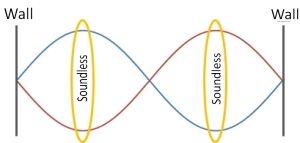
Twice the frequency of the fundamental wave of the standing wave. The sound disappears in two places in the room.
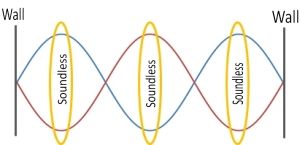
Three times the frequency of the standing wave fundamental. The sound disappears in three places in the room, but the gap between the silent parts is so narrow that the sound becomes less noticeable.
Let’s calculate the standing wave generated in the room (listening room)
What exactly is the sound that changes in size in the room?
Next, I will explain what kind of sound a standing wave generated in a room affects.
First, let’s calculate the frequency (pitch) of the standing wave generated in the room.
As an example, let’s suppose you put your speakers between 6 tatami mats.
Floor to ceiling height: 2.4m
Short side of room: 2.7m
The long side of the room: 3.6m
Sound speed: 340m / sec
Then,
The standing wave that can be created between the floor and the ceiling
(340m / s ÷ (2.4m × 2)) × 1 = 71Hz (fundamental wave)
(340m / s ÷ (2.4m × 2)) × 2 = 142Hz (twice the fundamental)
(340m / s ÷ (2.4m × 2)) × 3 = 213Hz (3 times the fundamental wave)
… and a standing wave that is an integral multiple of the fundamental wave continues forever.
Similarly, the standing wave on the short side of the room is
63Hz, 126Hz, 188Hz ・ ・ ・
The standing wave on the long side of the room
47Hz, 94Hz, 142Hz ・ ・ ・
It becomes.
The frequency of the fundamental wave more than three times is not so much of a problem because there are a lot of “belly” and “knots” in the room, but the fundamental wave and twice the frequency are the center of the room and the frequency of the room. Because “belly” occurs at 1/3 and 2/3 of the dimensions at the pinpoint, even amateur ears can clearly hear different sounds.
Specifically, if you listen to the sound in the center of the room, you will not hear any sound at 47Hz, 63Hz and 71Hz (fundamental waves of each side).
The frequency response from the speaker catalog is usually measured in an anechoic room.
An anechoic room is a room in which sound is not reflected at all and standing waves do not occur naturally.
I’ve been in an anechoic room at work before, but a room with no sound is very sick and uncomfortable if I’m not used to it.
When you enter the anechoic room, you can see how important the listening room is. Half of the sound coming out of the speaker is determined by the environment (acoustic performance) of the listening room. For this reason, those who have a taste for audio often lay a carpet in the room to prevent the reflection of sound from the floor, or lean against the wall side with jagged boards or perforated panels to diffuse the sound. . All these are done to control the standing waves in the room.
Even so, I think it is difficult for the general public to spend money on maintaining a listening room.
Here are some simple speaker installation methods that can improve the sound quality.
About the room to be installed
Considering standing waves, I think it is better to have different lengths for the “distance between floor and ceiling”, “short side of room”, and “long side of room”. In this way, the frequency of the standing wave can be dispersed. For example, in a typical 8 tatami room, the “short side of the room” and the “long side of the room” will be the same length, so a quite strong standing wave will be generated at the pinpoint frequency . It seems to be better for a 6-tatami room as a listening room.
Also, in rooms where a lot of furniture is placed near the walls, the sound is diffusely reflected, so the generation of standing waves can be suppressed. This is the image of replacing the reflector with furniture.
Where to place speakers
It is best to place the speakers at ear level. This is because the directivity (the property that the sound intensity varies depending on the direction) differs depending on the pitch of the sound. It sounds like
In the case of small speakers, most people will place it near the wall of the room.
In fact, the way bass is output depends on where you place the speakers.
Specifically, bass is least likely to appear when installed near the center, away from the room walls. (Actually, the sound of the original speaker comes out because it is not affected by the virtual image sound.) Conversely, when it is installed at the four corners of the wall, the bass is most likely to come out. The difference is about eight times the sound pressure. If you use this characteristic, if the bass is too high, move the speaker away from the wall and floor as much as possible.で あ れ ば If the bass is insufficient, place the speaker closer to the wall. (The four corners of the room have the lowest bass) Knowing this allows you to control the bass sound quality to some extent.
Personally, I think the sound will be more natural and better than controlling the bass with a graphic equalizer.
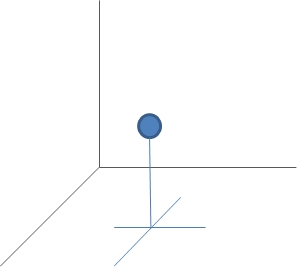
“A”: Use a speaker stand to place speakers away from the floor and walls.
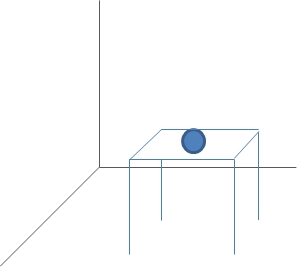
“B”: Place the speaker on the desk and away from the wall.
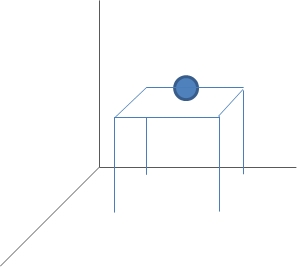
“C”: Place the speaker on a desk and close to the wall.

“D”: Place the speaker on the desk in the corner of the room.
In the above figure, the bass becomes louder in the order of “A → B → C → D”. (A bass is the weakest, D bass is the strongest)
However, in most cases, it is not possible to select the installation location because of the sound, and the bass frequency emphasized differs depending on the music source, so listening to ASCT (bass boost) in Light Years 01 You can adjust the condition in three stages. You can enjoy music with better sound quality if you adjust the ASCT according to the room to be installed and the song you listen to.
I have explained the relationship between the listening room and the speakers.
With the above in mind, there is a good chance that a slight change in the location of your speakers will significantly improve your audio life. If you want to enjoy more music and listen to good sound, please try it.

